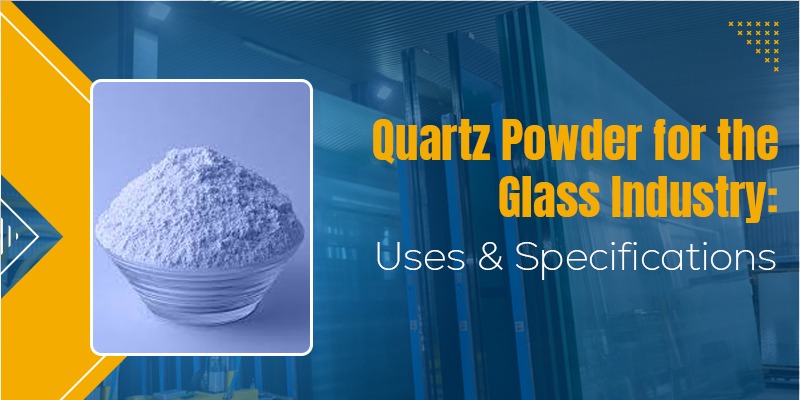
Quartz Powder for the Glass Industry: Uses & Specifications
Glass is all around us—windows, screens, bottles and so much more—but what lies at the core of this transparent substance? Quartz powder is the key solution for the glass industry. This finely ground, high-purity substance plays a vital role in the production and quality of glass, making it an indispensable raw material in both traditional and modern glass manufacturing.
Let’s find out why quartz powder is so important, from its chemical composition and physical properties to its contribution to innovation in the glass sector.
The Foundation of Glass: What is Quartz Powder?
Quartz powder is essentially a fine-grained form of silica (SiO₂), which comes from natural quartz mineral sources and is manufactured to provide high purity and stability. Quartz consists of over 99% silica in its purest form, along with a negligible amount of impurities (such as iron oxide or aluminum) that can dilute the clarity and color of the glass.
Due to its high melting point, hardness, and chemical stability, quartz powder is very well suited as an additive in glass manufacture. Mixed with other raw materials and heated to a suitable temperature, quartz powder, when taken individually, aids in the formation of a uniform glass matrix, which in turn constitutes the glass's transparency, as well as its strength and thermal resistance.
Quartz Powder’s Role in Glass Manufacturing
In the glass industry, quartz powder is the primary source of silica, an integral element that shapes glass. It can create many types of glass, including container glass, flat glass, fiberglass, specialty glass, and optical-grade glass.
Using quartz powder in glass industry allows manufacturers to consistently maintain quality in their products. Because it is finely sized, quartz powder can create a homogeneous mixture with other raw materials, which helps prevent defects, including bubbles, streaks, or discoloration, during the melting and cooling processes.
Key Specifications of Quartz Powder for Glass
The efficiency of quartz powder in creating glass is determined by its technical specifications. Quality quartz powder has to conform to strict standards to provide the best utility in the final glass product.
Typically the specifications are:
- SiO₂ Content: ≥ 99.5%
- SIron Oxide (Fe₂O₃): ≤ 0.02% (to prevent color contamination)
- Moisture Content: ≤ 0.2%
- Particle Size: 5 - 100 microns (dependent on glass type)
- Whiteness: ≥ 90%
These specifications allow manufacturers to produce high-quality, either transparent or opaque, and thermally stable glass for different types of applications spanning from architecture to electronics.
Enhancing Glass Properties: Clarity, Strength & Heat Resistance
The most important feature of quartz powder is the clarity it provides to glass. Quartz has a low iron content, which eliminates the potential for discoloration, creating crystal-like clarity for glasses used in optical applications, solar panels, and fine tableware.
Besides clarity, quartz powder adds strength and thermal shock resistance to glass. This is extremely valuable for products that routinely go through extreme thermal changes, such as laboratory glassware, oven-baked products, and even car windshields. The hardness of quartz also increases scratch resistance, thereby lengthening the life of glass products.
Modern Applications in Specialty Glass Industries
The demand for specialized glass has exploded with the advance of technology and smart materials. It is not just general industrial and decorative use but also high-tech glass in smartphones and tablets, such as touchscreens and LED panels, optical fibers, and the display glass found in the devices themselves.
Take solar energy, for example; ultra-clear glass produced from high-quality quartz powder material ensures maximum light transmission, thus maximizing efficiency. Or fiber optics and precision instruments—the purity of quartz powder ensures minimum signal loss and maximum performance. It also demonstrates how quartz powder plays a role in more than just traditional uses but is also a driver of established modern use.
Environmental and Economic Advantages
Apart from performance, quartz powder also plays a crucial role in promoting sustainability within the glassmaking industry. Its consistent properties enable more controlled melting and limit energy use and greenhouse gas emissions during production.
In addition, quartz is abundant and reusable. Waste glass, or cullet, can usually be melted down and mixed with fresh quartz powder, which reduces raw material consumption and supports a circular economy initiative in the glass industry.
Conclusion
Glass may seem simple in its form, but the production of glass is a very complex science, and quartz powder sits at the center of this science for the manufacture of high-performance modern glass products. From improving improved clarity and strength to contributing to sustainability, quartz powder is both an essential and integral raw material for the manufacture of glass in the glass industry.
Just like you are reading this on a computer or an LCD screen (glass), or in the windows that let the morning light into your home, quartz powder is what ensures clarity, strength, and innovation in every piece of glass.